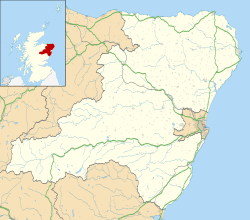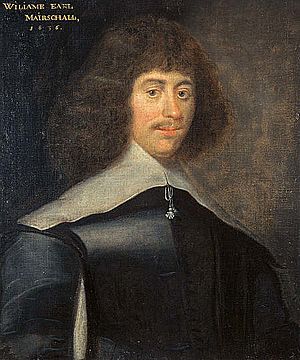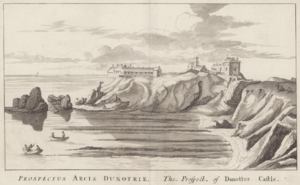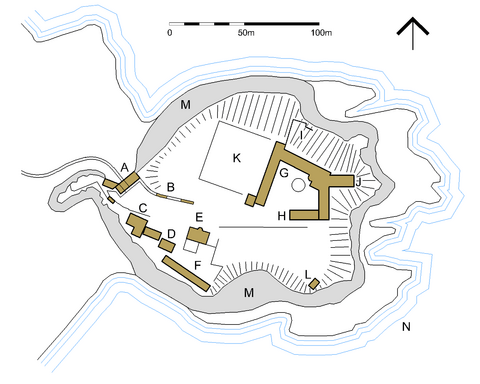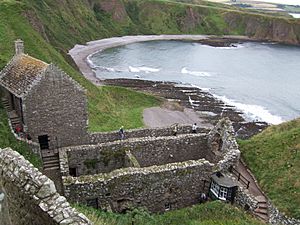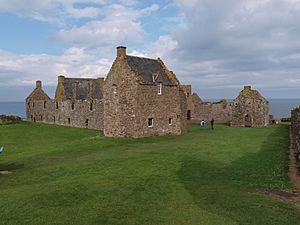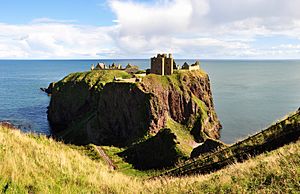Dunnottar Castle facts for kids
Quick facts for kids Dunnottar Castle |
|
|---|---|
| Dùn Fhoithear | |
| Near Stonehaven, Aberdeenshire, Scotland | |
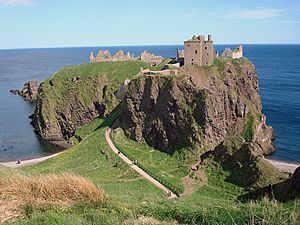
Dunnottar Castle
|
|
| Coordinates | 56°56′46″N 2°11′49″W / 56.946°N 2.197°W |
| Site information | |
| Owner | Dunecht Estates |
| Controlled by | Clan Keith, Earl Marischal |
| Open to the public |
Yes |
| Condition | Ruined |
| Site history | |
| Built | c.1400–1600 |
| In use | Until 1718 |
Dunnottar Castle (which means "fort on the shelving slope" in Scottish Gaelic) is a ruined castle on a rocky headland in Scotland. It's about 2 miles (3 km) south of Stonehaven on the country's northeast coast. Most of the buildings you see today were built in the 1400s and 1500s. However, people believe this spot was used as a fort much earlier, in the Early Middle Ages. Dunnottar Castle was very important in Scottish history because of its great location and strong defenses. It played a big role until the 1700s.
Dunnottar is most famous as the place where the Honours of Scotland were hidden. These are the Scottish crown jewels. They were kept safe from Oliver Cromwell's army in the 1600s. The Clan Keith owned the castle from the 1300s. It was the main home of the Earl Marischal. But the castle was left to ruin after the last Earl lost his titles for joining a rebellion in 1715. In the 1900s, the castle was repaired. Now, it is open for everyone to visit.
The castle ruins cover about 3.5 acres (1.4 hectares). They are surrounded by steep cliffs that drop 160 feet (49 meters) to the North Sea. A narrow strip of land connects the headland to the mainland. A steep path leads up to the castle's main gate. Inside, you can find a 14th-century tower house and a 16th-century palace. Dunnottar Castle is a protected historic site.
History of Dunnottar Castle
Early Times at Dunnottar
Some stories say that a chapel was built at Dunnottar in the 400s by St Ninian. But it's not clear when the first fort was built here. The earliest written records mention "Dún Foither" being attacked in 681 and 694. One attack might have been by Brude, a Pictish king, to expand his power. The Scottish Chronicle says that King Donald II of Scotland was killed at Dunnottar in 900 during a Viking attack. The English king Æthelstan also raided as far north as Dunnottar in 934.
Historians have looked for signs of an early fort under the current castle. But digs in the 1980s didn't find much proof of early medieval defenses. Some Pictish stones found nearby suggest that the very first fort might have been on a different headland.
Dunnottar in the Middle Ages
During the time of King William the Lion (1165–1214), Dunnottar was an important local center. The castle is even mentioned in an old story from the 1200s called the Roman de Fergus. In this tale, a hero must go to Dunnottar to find a magic shield. In 1276, a church on the site was officially opened by a bishop. The poet Blind Harry wrote that William Wallace captured Dunnottar from the English in 1297. This was during the Wars of Scottish Independence. It's said that Wallace trapped 4,000 English soldiers in the church and burned them alive.
In 1336, Edward III of England ordered ships to go to Dunnottar. He wanted the castle rebuilt and strengthened to help his army in the north. But the Scottish Regent, Sir Andrew Murray, soon captured and destroyed the castle's defenses again.
In the 1300s, Dunnottar was given to William Keith, Marischal of Scotland. He built the tower house at Dunnottar. But he was temporarily banned from the church for building on holy ground. He had to write to the Pope to lift the ban. William Keith's family later became the Earl Marischal. They owned Dunnottar until the 1700s.
Castle Changes in the 1500s
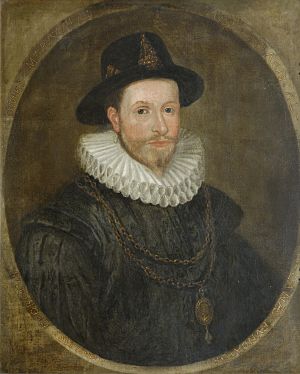
Scottish kings often visited Dunnottar. James IV of Scotland came in 1504. He listened to music and gave money to poor people. James V of Scotland said that Dunnottar was one of the "main strengths of our kingdom." This meant the Earl's men didn't have to serve in the army. Mary, Queen of Scots visited in 1562 and 1564. James VI stayed for 10 days in 1580. He even held a meeting of his special council at the castle.
In 1581, George Keith, 5th Earl Marischal took over the castle. He started a huge project to change the old fortress into a more comfortable home. He built a "palace" with many buildings around a courtyard on the cliffs. This created fancy living spaces with amazing sea views. The old chapel was also fixed up. A grand stone gatehouse was built, known as Benholm's Lodging. It had many gun ports facing the entrance. These were probably more for show than for real defense.
Dunnottar During the Civil Wars
In 1639, William Keith, 7th Earl Marischal, supported the Covenanters. This group wanted to change the church in Scotland. He fought against the Royalists. Later, when the Royalists attacked, the Earl stayed safe in Dunnottar.
After King Charles I was executed in 1649, his son Charles II of England became king. Charles II visited Dunnottar in July 1650. But Oliver Cromwell's army soon came to Scotland and defeated the Scots.
The Honours of Scotland
Charles II was crowned king in 1651. The Honours of Scotland (the crown, sword, and scepter) were used in the ceremony. But Cromwell's troops were nearby, so the Honours couldn't go back to Edinburgh. The Earl Marischal was in charge of them. So, in June, it was decided to hide them at Dunnottar. Katherine Drummond brought them to the castle, hidden in sacks of wool. Sir George Ogilvie was put in charge of defending the castle.
In November 1651, Cromwell's troops told Ogilvie to give up, but he refused. While the castle was under attack, a plan was made to remove the Honours. Elizabeth Douglas (Sir George Ogilvie's wife) and Christian Fletcher (a minister's wife) helped. First, the king's important papers were taken out by Anne Lindsay, hidden in her clothes.
There are two stories about how the Honours themselves were removed. Christian Fletcher said she carried the crown, scepter, sword, and sword-case out of the castle over several visits, hidden in sacks of goods. Another story says the Honours were lowered from the castle onto the beach. Christian Fletcher's servant then picked them up in a basket of seaweed. After getting them out, Christian Fletcher and her husband buried them under the floor of a church in Kinneff.
By May 1652, Cromwell's army had cannons ready to attack Dunnottar. Ogilvie gave up on May 24. But the Honours were gone! Cromwell's soldiers put Ogilvie and his wife in prison. They were released when a false story spread that the Honours had been sent overseas. Much of the castle's property was taken.
When Charles II became king again in 1660, the Honours were taken from Kinneff Church and given back to him. Ogilvie was rewarded for saving them. Christian Fletcher was promised money, but she never received it.
Whigs and Jacobites at Dunnottar
Religious and political fights continued at Dunnottar in the late 1600s and early 1700s. In 1685, during a rebellion, 167 Covenanters were captured. These were people who refused to swear loyalty to the new king, James VII. They were held in a cellar at Dunnottar from May to July. Twenty-five of them escaped, but some died or were caught again. Five prisoners died in the cellar. Thirty-seven were released after they swore loyalty. The rest were sent away to America. Many died on the journey. This cellar is now known as the "Whigs' Vault."
Both the Jacobites (who supported the old royal family) and the Hanoverians (who supported the new kings) used Dunnottar Castle. In 1689, the castle was held for King William III. In the Jacobite Rising of 1715, George Keith, 10th Earl Marischal, joined the rebels. After the rebellion failed, he had to leave Scotland. In 1716, his titles and lands, including Dunnottar, were taken by the crown.
Dunnottar's Later Years
In 1720, a company bought the Earl Marischal's lands. They took apart much of the castle. In 1761, the Earl briefly returned and bought Dunnottar back. But he sold it five years later to Alexander Keith of Dunnottar. The castle was passed down through the Keith family. In 1925, Weetman Pearson, 1st Viscount Cowdray, bought Dunnottar. His wife started a big project to repair the castle. Since then, the castle has stayed in their family. It is now open to the public and many visitors come each year.
Dunnottar Castle and its headland became a protected historic site in 1970. Some parts of the 1990 film Hamlet, starring Mel Gibson, were filmed there.
Exploring Dunnottar Castle
Dunnottar's location was very important. It allowed its owners to control the land between the sea cliffs and the hills. This area was a key route for getting to and from northeast Scotland. You can reach the castle by a steep 2,600-foot (790-meter) path from a car park. Or you can walk about 2 miles (3 km) along a path from Stonehaven.
Dunnottar has several buildings built between the 1200s and 1600s. They are spread across a headland that covers about 3.5 acres (1.4 hectares). The most noticeable building when you approach is the 14th-century tower house. Other main buildings include the gatehouse, the chapel, and the 16th-century "palace" which has the "Whigs' Vault."
Castle Defenses
The path to the castle is watched over by defenses on a nearby point called the "Fiddle Head." The main entrance is through a very strong gate. This gate is part of a wall that blocks a gap in the cliffs. The gate has a portcullis (a heavy metal gate that drops down). Next to the main gate is Benholm's Lodging, a five-story building built into the rock. It had a prison and rooms above. It also has three levels of gun ports facing outwards. Inside the main gate, four more gun ports face the entrance. The entrance path then turns sharply and goes through two tunnels underground before reaching the tower house area.
Some experts say these defenses are "the strongest in Scotland." However, others have questioned how effective the gun ports really were. They point out that some gun ports faced across the path instead of along it, which would limit their use.
There's another way into the castle from a rocky cove. This is a sea cave on the north side of the cliffs where a small boat could land. From there, a steep path leads to a well-protected back gate on the cliff top. This gate then leads into the castle through the Water Gate in the palace. There are also earth defenses with cannons on the northwest side (facing inland) and the southeast side (facing the sea). A small guard house stands by the eastern cannons, looking out over the coast.
Tower House and Other Buildings
The tower house, built in the late 1300s, has a stone basement. It originally had three more floors and an attic above. It was about 40 by 36 feet (12 by 11 meters) and stood 50 feet (15 meters) tall. The main rooms included a large hall and a private room for the lord, with bedrooms upstairs. Next to the tower house is a storage building and a blacksmith's workshop with a big chimney. Stables are located along the southern edge of the headland. Nearby is Waterton's Lodging, also called the Priest's House, built around 1574. This small house had a hall and kitchen on the ground floor, with private rooms above.
The Palace
The palace, on the northeast side of the headland, was built in the late 1500s and early 1600s. It has three main sections built around a courtyard. It was probably mostly built by the 5th Earl Marischal. It offered much more space and comfort than the tower house. Its long, low design was similar to English buildings of that time.
Seven identical rooms are along the west side. Each opened onto the courtyard and had windows and a fireplace. Above these rooms was a 120-foot (37-meter) long gallery. This gallery once had a fancy oak ceiling. At the north end of the gallery was a drawing room. The gallery could also be reached from the Silver House to the south, which had a wide staircase and a treasury above.
The basement of the north section has kitchens and storage rooms. Above them were a dining room and a large chamber. On the ground floor is the Water Gate, which leads to the back gate on the northern cliffs. The east and north sections are connected by a rectangular staircase. The east section has a larder, brewery, and bakery on the ground floor. Above these were rooms for the Countess. A northeast wing has the Earl's rooms, including the "King's Bedroom" where Charles II stayed. In this room, there's a carved stone with the family's symbols and the date 1645. Below these rooms is the Whigs' Vault, a cellar about 52 by 15 feet (16 by 4.6 meters). This is where the Covenanters were held in 1685. Only the dining room and the Silver House still have roofs, as they were repaired in the 1920s.
The central area has a round water tank or fish pond, about 50 feet (15 meters) across and 25 feet (7.6 meters) deep. There's also a bowling green to the west. In the southeast corner of the courtyard is the chapel, which was first opened in 1276 and mostly rebuilt in the 1500s. Some old walls and two 13th-century windows remain. There is also a graveyard nearby.
Images for kids
See also
 In Spanish: Castillo de Dunnottar para niños
In Spanish: Castillo de Dunnottar para niños


